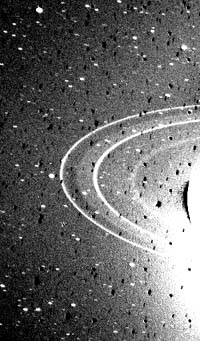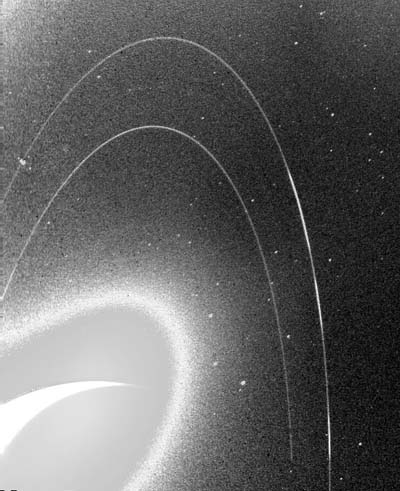Neptune Rings
Evidence for incomplete arcs around Neptune first arose in the mid-1980's, when stellar occultation experiments were found to occasionally show an extra "blink" just before or after the planet occulted the star. Images by Voyager 2 in 1989 settled the issue, when the ring system was found to contain several faint rings, the outermost of which, Adams, contains three prominent arcs now named Liberty, Equality and Fraternity. The existence of arcs is very difficult to understand because the laws of motion would predict that arcs spread out into a uniform ring over very short timescales. The gravitational effects of Galatea, a moon just inward from the ring, are now believed to confine the arcs. Several other rings were detected by the Voyager cameras. In addition to the narrow Adams Ring 63,000 km from the center of Neptune, the Leverrier Ring is at 53,000 km and the broader, fainter Galle Ring is at 42,000 km. A faint outward extension to the Leverrier Ring has been named Lassell; it is bounded at its outer edge by the Arago Ring at 57,000 km.
| Neptune rings | ||||
| Name | Distance* | Width | Albedo | Named after |
| 1989 N3R Galle | 41,900 km | 15 km | Low | Johann Galle |
| 1989 N2R Leverrier | 53,200 km | 15 km |
Low | Urbain Le Verrier |
| Lassell | 55,400 km | - | Low | William Lassell |
| Arago | 57,200 km | - | Low | François Arago |
| 1989 N1R Adams | 62,900 km | - | ? | John Couch Adams |
| Liberte ("Leading" Adams arc) | 62,930 km | < 50 km | Low | |
| Egalite ("Equidistant" Adams arc) | 62,900 km | - | ? | |
| Fraternite ("Following" Adams arc) | 62,900 km | - | ? | |
| Courage (arc) | 62,900 km | - | ? | |
| * The distance is measured from the planet center to the start of the ring. | ||||
Information from: SSE-JPL-NASA
The scheme of Neptune's ring-moon system. Solid lines denote rings; dashed lines denote orbits of moons.
Graphic:Fama Clamosa


